Portal:Yorkshire/Selected article
Adding a page
[edit]New selected articles should be at least GA class on the quality scale. To add a new selected article:
- Click on Portal:Yorkshire/Selected article/XX where XX is the number of the next article (for example Portal:Yorkshire/Selected article/15)
- Add about 200 words from the article, if possible add an image and set this to 150px.
- Add '''[[Name|(read more . . . )]]''' to the end of the text (Name is the title of the article)
- Edit the main page of Portal:Yorkshire and change max = in {{Random portal component|max=14|header=Selected article|footer=More articles...|subpage=Selected article}} to the number of the article (XX in the example above)

Sheffield is a city and metropolitan borough in South Yorkshire, England. It is so named because of its origins in a field on the River Sheaf that runs through the city. The city has grown from its largely industrial roots to encompass a wide economic base. The population of the City of Sheffield is estimated at 520,700 people (2005), and it is one of the eight largest English cities outside London, which form the English Core Cities Group. The wider Sheffield Urban Area, which extends beyond the city proper, has a population of 640,720.
Historically part of the West Riding of Yorkshire, Sheffield obtained world-wide recognition during the 19th century for its production of steel. Many innovations in the industry were developed locally, including crucible and stainless steel. This fuelled an almost tenfold increase in the population during the Industrial Revolution. It gained its city charter in 1893 and became officially titled the City of Sheffield. International competition caused a decline in local industry during the 1970s and 1980s, and at the same time the nearby national coal industry collapsed, affecting Sheffield's population. In recent years, Sheffield has re-invented itself as a sporting and technology city. (read more . . . )

Stocksbridge Park Steels Football Club is a football club based in Stocksbridge, South Yorkshire, playing in the Northern Premier League Division One South. The club was formed in 1986 after a merger between two other clubs, and initially played in the Northern Counties East League. In the 1993–94 season the team won the championship of this league but were ineligible to gain promotion to the Northern Premier League as their stadium did not meet the required standard. Two seasons later Stocksbridge finished as Northern Counties East League runners-up and this time gained promotion to the Northern Premier League Division One, where the team remained until the division was regionalised in 2007. The team have twice reached the play-offs for promotion to the Premier Division but lost on both occasions. The Stocksbridge team wear a yellow and blue kit and play at the Look Local Stadium, which was known as the Bracken Moor Stadium until the club secured a sponsorship deal with a local newspaper in 2006. The stadium adjoins a cricket pitch and the club was required to erect a dividing fence in order to meet the requirements of the Northern Premier League. (read more . . . )

Kingston upon Hull, almost invariably referred to as Hull, is a city and unitary authority area in the East Riding of Yorkshire, England. It is located on the north bank of the Humber estuary, near the Yorkshire coast. Sited 25 miles (40 km) from the North Sea, on both sides of the River Hull at its junction with the Humber, the city has a resident population of (2022). Renamed Kings town upon Hull by King Edward I in 1299, Hull has served as market town, trading hub, fishing and whaling centre, and industrial metropolis. Hull was an early theatre of battle in the English Civil Wars, and was the backdrop to events leading to the abolition of the slave trade in Britain.
It was unique in the United Kingdom in having a municipally owned telephone system from 1902, sporting cream, not red, telephone boxes. After suffering heavy damage during the Second World War, Hull weathered a period of post-industrial decline, when the city gained unfavourable results on measures of social deprivation, education and policing.
However, the city has recently embarked on a programme of regeneration and renewal and a range of sporting and cultural activities is available, with attractions including the historic Old Town and Museum Quarter, Hull Marina and The Deep. (read more . . . )
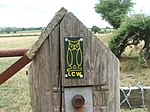
The Leeds Country Way is a circular long-distance footpath of 62 miles (99 km) around Leeds, West Yorkshire. It is nowhere further than 7 miles (11 km) from Leeds City Square, but is mainly rural with extensive views in the outlying areas of the Leeds metropolitan district. It follows public footpaths and minor lanes, with a few short sections along roads.
A route was first devised by Fred Andrews of the Ramblers Association, and then developed by West Yorkshire County Council in the early 1980s. This council was abolished in 1986, and the path is now under the care of the Countryside section of Leeds City Council. The Leeds Country Way was realigned in 2006, using a route devised by Bob Brewster, to bring it entirely within the boundary of the Leeds metropolitan district (previously it crossed the boundary into Wakefield), and the path was officially relaunched on 26 September 2006 with a revised set of map leaflets and improved waymarking. The path is waymarked in both directions and can be started at any point, but is described here clockwise from the A660 road at Golden Acre Park, divided into parts and sections which correspond with the official map leaflets. (read more . . . )

The M62 motorway is a west–east trans-Pennine motorway in northern England, connecting the cities of Liverpool and Hull. The road also forms part of the unsigned Euroroutes E20 (Shannon to Saint Petersburg) and E22 (Holyhead to Ishim). The road is 107 miles (172 km) long; however, for seven miles (11 km), it shares its route with the M60 motorway around Manchester.
The motorway, which was first proposed in the 1930s, and originally conceived as two separate routes, was built in stages between 1971 and 1976, with construction beginning at Pole Moor and finishing in Tarbock. Adjusted for inflation to 2007, the motorway cost approximately £765 million to build. The motorway is relatively busy, with an average daily traffic flow of 100,000 cars in Yorkshire, and has several areas prone to gridlock, in particular, between Leeds and Huddersfield in West Yorkshire.
The road passes the cities of Salford, Manchester, Bradford and Leeds. Between Liverpool and Manchester, and east of Leeds, the terrain of the road is relatively flat, while between Manchester and Leeds, the road crosses the hilly Pennines to its highest point on Saddleworth Moor, which is also the highest point of any motorway in the United Kingdom, at 1,221 feet (372 m) above sea level. (read more . . . )
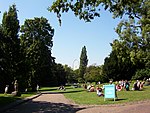
York Museum Gardens are botanic gardens in the centre of York, England. They cover an area of 10 acres (4.0 ha) of the former grounds of St Mary's Abbey, and, along with the Yorkshire Museum, they were created during the 1830s by the Yorkshire Philosophical Society. They are held on trust by the City of York Council and managed by the York Museums Trust. The gardens were designed by landscape architect Sir John Murray Naysmith in a gardenesque style, and contain a variety of species of plants, trees and birds. Admission is free.
There are several historic buildings in the gardens. They contain the remains of the west corner of the Roman fort of Eboracum, including the Multangular Tower and parts of the Roman walls. Most of the other buildings dating from the Middle Ages are associated with St. Mary's Abbey. The remains of St. Leonard's Hospital chapel and undercroft are on the east side of the gardens. The Yorkshire Philosophical Society constructed several buildings in the gardens during the 19th and early 20th century, including the Yorkshire Museum and its octagonal observatory. The museum houses four permanent collections, covering biology, geology, archaeology and astronomy. (read more . . . )

The LNER Class A3 Pacific steam locomotive No. 4472 Flying Scotsman (originally No. 1472) was built in 1923 for the London and North Eastern Railway (LNER) at Doncaster Works to a design of H.N. Gresley. It was employed on long-distance express trains on the LNER and its successors, British Railways Eastern and North-Eastern Regions, notably on the 10am London to Edinburgh Flying Scotsman train service after which it was named. Flying Scotsman is regarded as the world's most famous steam locomotive.
The locomotive is notable for having set two world records for steam traction; becoming the first steam locomotive to be officially authenticated at reaching 100 miles per hour (160.9 km/h) on 30 November 1934, and then setting a record for the longest non-stop run by a steam locomotive when it ran 422 miles (679 km) on 8 August 1989.
Retired from regular service in 1963 after covering 2,076,000 miles (3,341,000 km), Flying Scotsman gained considerable fame in preservation under the ownership of Alan Pegler, William McAlpine, Tony Marchington and finally the National Railway Museum. As well as hauling enthusiast specials in the United Kingdom, the locomotive toured extensively in the United States and Australia. (read more . . . )

Last of the Summer Wine is a British National Television Award winning sitcom which airs on BBC One and is written by Roy Clarke and produced and directed by Alan J. W. Bell. Last of the Summer Wine originally premiered as an episode of Comedy Playhouse on 4 January 1973, with the first series of episodes following on 12 November 1973. The 30th series premiered on 19 April 2009 and concluded on 21 June 2009. On the 26 June 2009 the BBC announced that it had recommissioned the show for its 31st series, consisting of six episodes to be broadcast in 2010. Reruns of the show air in the UK on satellite stations UKTV Gold and UKTV Drama and in over twenty-five countries, including various PBS stations in the United States. Last of the Summer Wine is the longest-running comedy programme in Britain and the longest-running sitcom in the world. Set and filmed in Holmfirth, West Yorkshire, England, the plot centres around a trio of older men, the lineup of whom has changed over the years, but originally consisted of the scruffy and child-like Compo, deep-thinking and meek Clegg, and authoritarian and snobbish Blamire, who was replaced by war veteran Foggy after two series in 1976. The three never seem to grow up, revelling in youthful stunts, and always finding a unique perspective on their equally eccentric fellow townspeople. (read more . . . )

Valley Parade is an all-seater football stadium in Bradford, West Yorkshire, England. It was built in 1886, and was the home of Manningham Rugby Football Club until 1903, when they changed code from rugby football to association football and became Bradford City. It has been Bradford City's home since, although it is now owned by former chairman Gordon Gibb's pension fund. It has also been home to Bradford Park Avenue for one season, and Bradford Bulls rugby league side for two seasons.
Football architect Archibald Leitch was commissioned to redevelop the ground when Bradford City were promoted to the First Division in 1908. From then, the stadium underwent few changes until 1985, when it was the scene of a fatal fire on 11 May 1985, when 56 supporters were killed and at least 265 were injured, the worst fire disaster in the history of English football.
It underwent a £2.6 million redevelopment and was re-opened in December 1986. The ground has undergone significant changes in the 1990s and early 2000s and now has a capacity of 25,136. The record attendance of 39,146 was set in 1911 for an FA Cup tie against Burnley, making it the oldest surviving attendance record at a Football League ground in the country. (read more . . . )
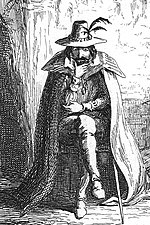
Guy Fawkes (13 April 1570 – 31 January 1606), also known as Guido Fawkes, the name he adopted while fighting for the Spanish in the Low Countries, was a member of a group of provincial English Catholics who planned the failed Gunpowder Plot of 1605.
Fawkes was born and educated in York. His father died when Fawkes was eight years old, after which his mother married a recusant Catholic. Fawkes later converted to Catholicism and left for the continent, where he fought in the Eighty Years' War on the side of Catholic Spain against Protestant Dutch reformers. He travelled to Spain to seek support for a Catholic rebellion in England but was unsuccessful. He later met Thomas Wintour, with whom he returned to England.
Wintour introduced Fawkes to Robert Catesby, who planned to assassinate King James I and restore a Catholic monarch to the throne. The plotters secured the lease to an undercroft beneath the House of Lords, and Fawkes was placed in charge of the gunpowder they stockpiled there. Prompted by the receipt of an anonymous letter, the authorities searched Westminster Palace during the early hours of 5 November, and found Fawkes guarding the explosives. Over the next few days, he was questioned and tortured, and eventually he broke. Immediately before his execution on 31 January, Fawkes jumped from the scaffold where he was to be hanged and broke his neck, thus avoiding the agony of the mutilation that followed.
Fawkes became synonymous with the Gunpowder Plot, the failure of which has been commemorated in England since 5 November 1605. His effigy is traditionally burned on a bonfire, commonly accompanied by a firework display. (read more . . . )

Sheffield Wednesday Football Club is a professional football club based in Sheffield who currently compete in the Football League of England in The Championship division. Wednesday are one of the oldest professional clubs in the world. Their main rivals are Sheffield United, with whom they contest the Steel City derby. The Owls have won four League titles, three FA Cups and one League Cup, but their League Cup triumph in 1991 is their only major trophy since World War II. They play their home matches at Hillsborough Stadium in the north-western suburb of Owlerton, a 38,814 all-seater stadium built in 1899 when the lease expired at their previous ground at Olive Grove. The largest attendance was 72,841, which was achieved in 1934.
Since their move to Owlerton, the owl has become a theme that has run throughout the club. The original club crest was introduced in 1956 and consisted of a shield showing a traditionally drawn owl perched on a branch. The White Rose of York was depicted below the branch alluding to the home county of Yorkshire and the sheaves of Sheffield (Sheaf field) were shown at either side of the owl's head. (Read more...)

The Battle of Marston Moor was fought on 2 July 1644, during the First English Civil War. The combined forces of the Scottish Covenanters under the Earl of Leven and the Parliamentarians under Lord Fairfax and the Earl of Manchester defeated the Royalists commanded by Prince Rupert of the Rhine and the Marquess of Newcastle. After their defeat the Royalists effectively abandoned the north of England, and lost access to the continent.
During the summer of 1644, the Covenanters and Parliamentarians had been besieging York which was defended by the Marquess of Newcastle. Prince Rupert had gathered an army to relieve the city, gathering fresh recruits on the way. The convergence of these forces made the ensuing battle the largest of the Civil Wars.
On 1 July, Rupert had outmanoeuvred the Scots and Parliamentarians to relieve the city. The next day, he sought battle with them, even though he was outnumbered. He was dissuaded from attacking immediately, and during the day both sides gathered their full strength on Marston Moor, an expanse of moorland west of York. Towards evening, the Scots and Parliamentarians themselves launched a surprise attack. After a confused fight lasting two hours, Parliamentarian cavalry under Oliver Cromwell routed the Royalist cavalry from the field and annihilated the remaining Royalist infantry. (read more . . . )

Whitby is a seaside town, port and civil parish in the Borough of Scarborough and English county of North Yorkshire. Situated on the east coast of Yorkshire at the mouth of the River Esk, Whitby has a combined maritime, mineral and tourist heritage, and is home to the ruins of Whitby Abbey where Caedmon, the earliest English poet, lived. The fishing port emerged during the Middle Ages and developed important herring and whaling fleets, and was where Captain Cook learned seamanship. Tourism started in Whitby in Georgian times and developed with the coming of the railway in 1839. Tourist interest is enhanced by its location surrounded by the high ground of the North York Moors national park and heritage coastline and by association with the horror novel Dracula. Jet and alum were mined locally, and Whitby jet, which was mined by the Romans and Victorians became fashionable during the 19th century.
The abbey ruin at the top of the east cliff is the town's oldest and most prominent landmark with the swing bridge across the River Esk and the harbour sheltered by the grade II listed east and west piers being other significant features. Statues of James Cook and William Scoresby and a whalebone arch all point to a maritime heritage. The town also has a strong literary tradition and has featured in literary works, television and cinema; most famously in Bram Stoker's novel, Dracula. (read more . . . )

The River Hull is a navigable river in the East Riding of Yorkshire in the north of England. It rises from a series of springs to the west of Driffield, and enters the Humber estuary at Kingston upon Hull. Following a period when the Archbishops of York charged tolls for its use, it became a free navigation. The upper reaches became part of the Driffield Navigation from 1770, after which they were again subject to tolls, and the section within the city of Hull came under the jurisdiction of the Port of Hull, with the same result.
Most of its course is through low lying land that is at or just above sea level, and flooding has been a long-standing problem. Drainage schemes to alleviate it were constructed on both sides of the river. The Holderness Drainage scheme to the east was completed in 1772, with a second phase in 1805, and the Beverley and Barmston Drain to the west was completed in 1810. There has been a tidal barrier since 1980.
Most of the bridges which cross the river are movable, in order to allow shipping to pass. There are five swing bridges, with a sixth one expected to open in 2013, four bascule bridges, two of which have twin leaves, one for each carriageway of the roads which they carry, and three Scherzer lift bridges, which are a type of rolling bascule bridge. However one, Scott Street Bridge, is now permanently raised. (read more . . . )
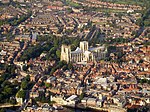
York is a walled city, situated at the confluence of the Rivers Ouse and Foss in North Yorkshire, England. The city has a rich heritage and provided the backdrop to major political events throughout much of its two millennia of existence.
The city was founded by the pre-Roman Brythonic people and named Eborakon meaning "place of the yew trees", and later called Eboracum in 71 AD by the Romans who made it the capital of their Province of Britannia Inferior. At the end of Roman rule in 415 AD the settlement was taken over by the Angles and the city was renamed Eoforwic. It served as the capital of the Anglian Kingdom of Northumbria. When the Vikings captured the city in 866 AD they renamed it Jórvík and it became the capital of a wider kingdom of the same name covering much of Northern England. After the Norman Conquest, the name "York", which was first used in the 13th century, gradually evolved. In the Middle Ages York grew as a major wool trading centre and the ecclesiastical capital of the northern province of England. The Province of York is still one of the two Church of England ecclesiastical provinces, alongside that of Canterbury.
York's location on the River Ouse, in the centre of the Vale of York and half way between the capitals of London and Edinburgh means that it has long had a significant position in the nation's transport system. The 19th century saw York, under the influence of George Hudson, become an important hub of the railway network and a manufacturing centre. In recent decades the economy of York has moved from being dominated by its confectionery and railway-related industries to one that provides services. The University of York and health services have become major employers. Tourism also boosts the local economy because the city offers a wealth of historic attractions, of which York Minster is the most prominent, and a variety of cultural activities. York Racecourse and Kit Kat Crescent, the home of York City F.C., are the most prominent sporting venues in the city and the River Ouse provides opportunities for both sporting and leisure pursuits. (read more . . . )

The Cottingley Fairies appear in a series of five photographs taken by Elsie Wright and Frances Griffiths, two young cousins who lived in Cottingley, near Bradford in England. In 1917, when the first two photographs were taken, Elsie was 16 years old and Frances was 10. The pictures came to the attention of writer Sir Arthur Conan Doyle, who used them to illustrate an article on fairies he had been commissioned to write for the Christmas 1920 edition of The Strand Magazine. Conan Doyle, as a Spiritualist, was enthusiastic about the photographs, and interpreted them as clear and visible evidence of psychic phenomena. Public reaction was mixed; some accepted that the images were genuine, but others believed they had been faked.
Interest in the Cottingley Fairies gradually declined after 1921. Both girls grew up, married and lived abroad for a time. Yet, the photographs continued to hold the public imagination; in 1966 a reporter from the Daily Express newspaper traced Elsie, who had by then returned to the UK. Elsie left open the possibility that she believed she had photographed her thoughts, and the media once again became interested in the story. In the early 1980s, both admitted that the photographs were faked using cardboard cutouts of fairies copied from a popular children's book of the time. Yet Frances continued to claim that the fifth and final photograph was genuine.
Today, the photographs and two of the cameras used are on display in the National Science and Media Museum in Bradford. (read more . . . )
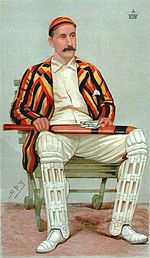
The Yorkshire captaincy affair of 1927 arose from a disagreement among members of Yorkshire County Cricket Club over the selection of a new captain to succeed the retired Major Arthur Lupton. The main issue was whether a professional cricketer should be appointed to the post. A tradition had been established throughout English county cricket that captains should always be amateurs. At Yorkshire, a succession of amateur captains had recently held office, on the grounds of their supposed leadership qualities, though none of them were worth their place in the side as cricketers. None of these skippers had lasted long; after Lupton's departure some members felt it was time that a more accomplished cricketer was appointed, on a longer-term basis.
The Yorkshire committee, prompted by the influential county president, Lord Hawke, made an approach to Herbert Sutcliffe, one of the side's leading professionals. After Sutcliffe's provisional acceptance of the captaincy, controversy arose and the members were divided. Some objected to the appointment on the traditional grounds that Sutcliffe was not an amateur; others felt that if a professional was to be appointed, then the post should be offered to the county's senior professional, Wilfred Rhodes, who had been playing much longer than Sutcliffe. Rhodes himself was offended that he had not been approached. When Sutcliffe became aware of the controversy, he withdrew his acceptance. No offer was made to Rhodes, and the county subsequently appointed amateur William Worsley as captain. Worsley lasted for two seasons, and was followed by two more short-term leaders. In 1933 Brian Sellers, a more competent amateur, was appointed and became the long-serving captain that Yorkshire had sought. (read more . . . )

The Battle of Towton was the "largest and bloodiest battle ever fought on English soil". The engagement took place near the village of the same name in Yorkshire on 29 March 1461, a Palm Sunday. It was part of the series of civil wars—the Wars of the Roses—fought between the Houses of Lancaster and York. More than 50,000 soldiers were mustered for this battle. The reigning king of England, Henry VI, headed the Lancastrians, while the Yorkists were led by Edward IV, who had declared himself king and was using this battle to affirm his claim. Their armies met on a plateau near Towton amidst a snowstorm. The Lancastrians, superior in numbers, were lured out of their defensive positions by the Yorkist archers, who took advantage of the strong wind to outrange their counterparts and inflict casualties without suffering any in return. The ensuing melee raged for hours, and the Yorkists finally gained victory after the arrival of their reinforcements. Many Lancastrians were killed in their panicked flight from the battlefield, and the heralds reported a count of 28,000 dead. Henry fled to Scotland, leaving Edward free to start the Yorkist dynasty. (more...)
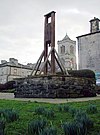
The Halifax Gibbet was an early guillotine, or decapitating machine, used in the town of Halifax, West Yorkshire, England. It was probably installed some time during the 16th century as an alternative to beheading by axe or sword. Halifax was once part of the Manor of Wakefield, where ancient custom and law gave the lord of the manor the authority to execute summarily by decapitation any thief caught with stolen goods to the value of 13½ pence or more, or who confessed to having stolen goods of at least that value. Decapitation was a fairly common method of execution in England, but Halifax was unusual in two respects: it employed a guillotine-like machine that appears to be unique in the country; and it continued to decapitate petty criminals until the middle of the 17th century. (more...)

Middleton is a largely residential suburb of Leeds in West Yorkshire, England and historically a village in the West Riding of Yorkshire. It is situated on a hill 4 miles (6 km) south of Leeds city centre and 165 miles (266 km) north north-west of London. In 2001 the population of the Middleton Park ward of Leeds City Council was 27,487.
Middleton was occupied before the Norman Conquest and recorded in the Domesday Book of 1086. It developed as a manorial estate and its owners began to exploit the coal seams which outcropped within its boundaries. At the start of the Industrial Revolution a wooden wagonway was built to link the coal pits to Leeds. The colliery agent, John Blenkinsop designed an iron railway and its first steam-powered locomotive which was built by Matthew Murray in Holbeck. The coal mines on which the local economy was based lasted until 1967 and the railway is a preserved and run by a trust after operating for 200 years.
Middleton Park, a remnant of the manorial estate, contains a large area of ancient woodland and parts of it, where coal was mined, are designated a scheduled ancient monument. It was the location of Middleton Hall and Middleton Lodge homes to the local gentry.
The village developed along Town Street, a school, chapel and church were built in the 19th century but after the land was acquired by Leeds Council in 1920 a large council housing estate was built on the flatter land to the south, completely changing the rural nature of the settlement. (read more . . . )

The history of Sheffield, a city in South Yorkshire, England, can be traced back to the founding of a settlement in a clearing beside the River Sheaf in the second half of the 1st millennium AD. The area now known as Sheffield had seen human occupation since at least the last ice age, but significant growth in the settlements that are now incorporated into the city did not occur until the Industrial Revolution.
Following the Norman conquest of England, Sheffield Castle was built to control the Saxon settlements and Sheffield developed into a small town, no larger than Sheffield City Centre. By the 14th century Sheffield was noted for the production of knives, and by 1600 it had become the main centre of cutlery production in England, overseen by the Company of Cutlers in Hallamshire. In the 1740s the crucible steel process was improved by Sheffield resident Benjamin Huntsman, allowing a much better production quality. At about the same time, the silver plating process which produced Sheffield Plate was discovered. The associated industries led to the rapid growth of Sheffield; the town was incorporated as a borough in 1843 and granted a city charter in 1893.
Sheffield remained a major industrial city throughout the first half of the 20th century, but the downturn in world trade following the 1973 oil crisis, technological improvements and economies of scale, and a wide-reaching rationalisation in steel production throughout the European Economic Community led to the closure of many of the steelworks from the early 1970s onward. Urban and economic regeneration schemes, initiated in the late 1980s, have since transformed the city. (read more . . . )

The Church of Saint Oswald, King and Martyr is a Church of England church serving the village and parish of Oswaldkirk, North Yorkshire, England. It is located along the main road passing through the village, the B7363 road (Oswaldkirk Main Street),1.5 miles (2.4 km) east of Ampleforth Abbey.
Dedicated to the Christian saint Saint Oswald, it is over 900 years old and run by the Church of England. It is part of a four-parish benefice, and is in the archdeaconry of Cleveland, and the diocese of York. Notably, the future Archbishop of Canterbury and chaplain to King Charles II, John Tillotson, preached his first sermon at the church in 1661. Major restoration work was done to the church in 1886, and a large amount of the Chancel woodwork dates from this period. The church has been a Grade II* listed building since 1955, and is the oldest building in the village by more than six centuries. (read more . . . )

Drax is a large coal-fired power station in North Yorkshire, England, capable of co-firing biomass and petcoke. It is situated near the River Ouse between Selby and Goole, and its name comes from the nearby village of Drax. Its generating capacity of 3,960 megawatts is the highest of any power station in the United Kingdom and Western Europe, providing about 7% of the United Kingdom's electricity supply.
Opened in 1974 and extended in the mid-1980s, the station was initially operated by the Central Electricity Generating Board, but sinceprivatisation in 1990 the station has changed owner several times, and is currently operated by Drax Group plc. Completed in 1986, Drax is the most recently built coal-fired power station in England, and by implementing technologies such as flue gas desulphurisation, is one of the cleanest and most efficient coal-fired power stations in the UK. However, because of its large size, it is also the UK's single largest emitter of carbon dioxide.
In an attempt to reduce these emissions, the station is currently (c.2010) co-firing biomass and underwent a turbine refurbishment between 2007 and 2012. In 2012 the company announced plans to convert up to three generating units to solely biomass fired power. (read more . . . )

Gisborough Priory is a ruined Augustinian priory in Guisborough in the borough of Redcar and Cleveland and ceremonial county of North Yorkshire, England. It was founded in 1119 as the Priory of St Mary by Robert de Brus, 1st Lord of Annandale, an ancestor of the Scottish king, Robert the Bruce. It became one of the richest monastic foundations in England with grants from the crown and bequests from de Brus, other nobles and gentry and local people of more modest means. Much of the Romanesque Norman priory was destroyed in a fire in 1289. It was rebuilt in the Gothic style on a grander scale over the following century. Its remains are regarded as among the finest surviving examples of early Gothic architecture in England.
The priory prospered until the Dissolution of the Monasteries in 1540, when it was abolished along with England's other monastic communities. The priory buildings were demolished and the stone re-used in other buildings in Guisborough. The east end of the priory church was left standing with its great window forming a distinctive arch, a well-known landmark used as a symbol for Guisborough. It became part of the estate of the Chaloner family, who acquired it in 1550. The east window was preserved by them as part of a Romantic vista adjoining their seat, Gisborough Hall, from which the priory takes its idiosyncratically spelled name. It is owned by the Chaloners but is in the care of English Heritage as a scheduled monument. (read more . . . )

The Battle of Boroughbridge was a battle fought on 16 March 1322 between a group of rebellious barons and King Edward II of England, near Boroughbridge, northwest of York. The culmination of a long period of antagonism between the king and Thomas, Earl of Lancaster, his most powerful subject, it resulted in Lancaster's defeat and execution. This allowed Edward to re-establish royal authority, and hold on to power for another five years.
Not in itself a part of the Wars of Scottish Independence, the battle is significant for its employment of tactics learned in the Scottish wars in a domestic, English conflict. Both the extensive use of foot soldiers rather than cavalry, and the heavy impact caused by the longbow, represented significant steps in military developments. (read more . . . )
